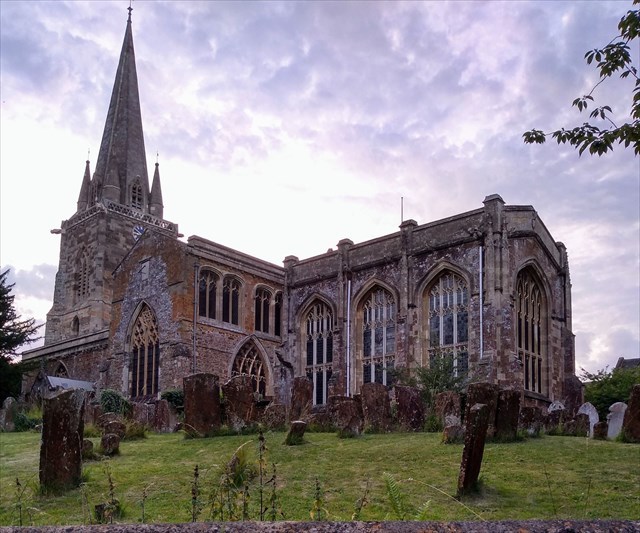
The ancient parish of Adderbury which included the townships of Adderbury East, Adderbury West, Bodicote, Barford St John and Milton is situated in North Oxfordshire close to the historic market town of Banbury. The parish church of Saint Mary the Virgin retains evidence of its 13th century origins but was enlarged in the 14th and 15th centuries.
Having fallen into disrepair during the 18th century, St Mary's was restored in three phases by three different architects. J.C. Buckler between 1831 and 1834, Sir George Gilbert Scott between 1866 and 1870, and then in 1886 by John Oldrid Scott.
A refurbishment of the exterior stonework was completed in 2019.
Stratigraphy is the branch of geology concerned with the order and relative position of strata and their relationship to the Geological Time Scale (GTS). The GTS is used by Earth scientists to describe the timing and relationships of events that have occurred during Earth's history. The primary defined units of time are eons, the first three are collectively referred to as the Precambrian supereon. Eons are subdivided into eras, which in turn are divided into periods, then epochs and finally ages. There are corresponding terms used to refer to the different rock layers which include eonothem, erathem, system, series and stage. When referring to time, Geologists qualify the units as early, mid, and late while the corresponding rock layers are referred to as lower, middle, and upper.
The area around Banbury in North Oxfordshire is underlain by clays and limestones. The majority of the visible geology, which is known as the Lias Group, was formed in the Early Jurassic period and is around 200 to 175 million years old. The Jurassic Period derives its name from the Jura Mountains where limestone strata from the period were first identified.
The environment when the Lias Group was formed was extremely different from that of today. The area of land that is now England was situated much further south, between about 30 and 40 degrees north of the equator, and was submerged beneath a relatively shallow, subtropical sea. The sea level varied, and during times when the sea level was high, the calm and quiet conditions allowed tiny clay minerals to accumulate on the seafloor and eventually formed dark coloured clays. When the sea level was low sedimentary rocks known as limestones were formed. One of these limestone bands, called the Marlstone Rock Bed is a particularly important building material in northern Oxfordshire.
Marlston, also known as Hornstone or Banbury Ironstone, is generally dark orange in appearance, this results from the high ferric (III) oxide (or rust) content of the rock and for this reason it is often referred to as Ironstone. However, greenish-blue Marlstone which contains ferrous (II) salts can also be found; this results where oxidation has yet to occur, or where the oxidised layer has peeled away leaving a fresh surface underneath. Marlstone is vulnerable to weathering; acid in rain water reacts with the calcite minerals in the rock and dissolves them away, this causes the surface to crumble and flake. The rock often contains fossils including belemnites and brachiopods. Belemnites are an extinct order of squid-like creatures with an internal skeleton while brachiopods have hard shells that are hinged at the rear which can be opened for feeding or closed for protection.
Another important building stone was also formed during the Mesozoic Era but this time in the Middle Jurassic period some 161 to 175 million years ago, it is known as Chipping Norton Limestone. This buff to white, medium to coarse-grained limestone is part of the Great Oolite Group. It was formed when tiny fragments of shells and other organic remains fell to the sea floor and were gently rolled around by currents and waves. The fragments became coated in successive layers of the mud to form small round balls, around a quarter of a millimetre in diameter and known as ooids. The shape and size of the ooids means that the stone can easily be cut in any direction giving a superb, smooth finish and as a result this type of limestone is often referred to as freestone.
You do not need to enter the church to gather the information but a visit is worthwhile. When you enter the churchyard take the path to the left which will bring you to a porched entrance with an open metal door.
To claim this EarthCache, please answers to the questions below and either email or message the answers to me. You do not need to wait for a response before logging the find. Please do not include any answer to the questions in your log, thank you.
- What Era does the Jurassic period belong to?
a) Cenozoic b) Mesozoic c) Paleozoic
- What is the origin of the term Jurassic?
a) The island of Jura b) The Juravenator dinosaur c) The Jura Mountains
- In total, how many worn stone carvings are located on each side of the porch at a height of around 3m?
a) 5 b) 14 c) 21
- Describe two locations on the church where each of the building stones highlighted above have been used? Why do you think each type of stone was selected for these locations.
- Walk around to the doorway on the opposite side of the church and look on the right hand side of the porch wall at eye level. What type of fossil do you see? Now look two stones higher, what fossil do you see here? Feel free to take a picture but please do not damage the fossils.
Thanks for visiting my EarthCache.
****************** ********************
For full information on how you can expand the Church Micro series by sadexploration please read the Place your own Church Micro page before you contact him at churchmicro.co.uk
See also the Church Micro Statistics and Home pages for further information about the series.
****************** *******************
*** Congratulations to Pesh on being FTF ***